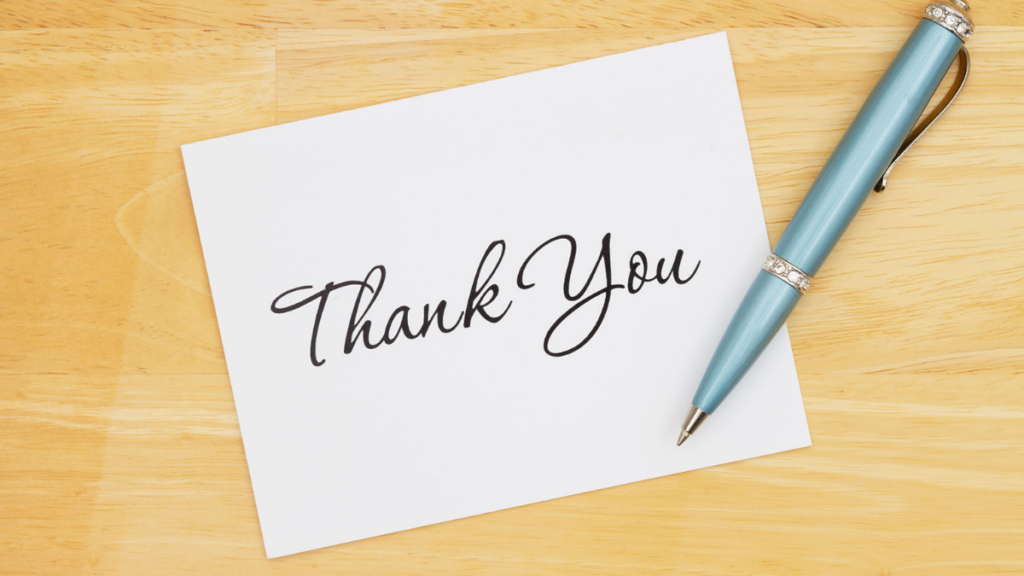Have you ever wondered how you should go about contacting an interviewer after a medical, dental, veterinary, or podiatry school interview? Although it may seem trivial, this is an important yet often overlooked aspect of the interview process. A strong thank-you letter can set you apart from your competitors, as it gives you an opportunity to provide reflection, express your appreciation, and engage in a final connection with admissions.
So, what does a great follow-up thank-you letter to a health-professions program interviewer look like?
Below are five steps to successfully navigating admissions, post-interview.
- What should be included in the email’s subject line and body?
The subject line should simply read “Thank you.” A short subject quickly grabs the reader’s attention.
Similarly, the body of the email should be kept short and simple.
Finally, include your application ID number as part of your signature if you have been given one by an application service.
For example:
Dear Dr. Maria Hernandez,
I have attached a post-interview thank-you note.
Sincerely,
Michael Smith
Application ID - How should I send the letter?
A thank you letter should always be sent as a PDF attachment. This will allow your letter to be read in the format originally intended. If you give a good interview and you send a professional and compelling thank you letter, the interviewer may forward the attachment to admissions. Admissions can then easily print or upload your letter into your file. This increases the likelihood that other committee members will see your letter when your file is being reviewed. This, in turn, puts you in better standing with the committee.
- What should I include in the letter?
Avoid the trap of writing a thank you letter that focuses solely on connecting with the
interviewer. Instead, try to connect with anyone who may read your letter. When people who
were not present during the interview read your response, they should have a clear sense of the
highlights of your interview. Consider the interviewer as a liaison that forwards the most relevant information about you, the interviewee, to the committee.
Begin your letter by thanking the interviewer for his/her time. Faculty members have busy
schedules and acknowledging this creates a tone of respect and appreciation. Speaking of busy schedules, be mindful of the length of your letter; try not to exceed half a page in length.
If over the course of the interview you learned something new about the program, mention that.
Be as specific as possible and address the value/significance of what you learned.
You should also reiterate your excitement for the school and the opportunities you plan to take
advantage of if accepted.
After writing the letter, take a moment to step away before proofreading. This will allow you to
look at your letter with a fresh set of eyes. When proofreading, be sure to read your letter out
loud, as this will help you catch typos or errors with your syntax that you may otherwise
overlook.
An example thank-you letter can be found below:
Date (right align)
Dear Name (include his/her proper title)
I want to thank you for taking the time to interview me for possible admission into your dental
program. Through the course of the interview, I learned even more about this prestigious
program.
One thing that really interests me is the Summer Research Fellowship Program. Such a program
would allow me to refine my research skills and continue conducting the research that I love
while expanding my knowledge about the disease. It would further provide me with an amazing
opportunity to continue improving my presentation skills as I would be presenting my research at Student Research Day.
If I am fortunate enough to receive an offer of admission, I will accept without hesitation. The
integrated medical school curriculum will provide me with the knowledge necessary to
effectively communicate with medical doctors and dentists in my research area, and I would love to be part of such a tight-knit collegial community.
Warmest regards,
Michael Smith
Application ID
I reached out to a physician research mentor of mine who previously conducted medical school
admissions interviews and asked him what he would expect in a thank you letter:
“Ideally, a personalized note is the best. This means you discuss something in particular
referring to the interview. For example, one student asked about a combined MBA/MD program
at the University of Rochester which led to further emails and an acceptance to the program.
A creative note card is usually beyond the scope of those who are not artists but does show an
important aspect. Few students have excellent penmanship, but calligraphy may be rewarded.” - When should I send my thank you letter?
Ideally, you should send your letter on the same day as the interview. If that is not possible, it
should be within 24 hours. - How should the letter be formatted?
It’s best to use standard formatting; Times New Roman and 12-point font are never going to go
out of style. Don’t include a heading, but you should include the date in the upper right-hand
corner of your word document. Additionally, a signature is a great way to demonstrate
professionalism. There are a lot of resources available online to help you create your own digital
signature quickly if you don’t already have one.
Once you get a template created, it will be easy to build additional letters for future interviews. Make sure you stand out – in a good way – by sending effective thank you notes.
